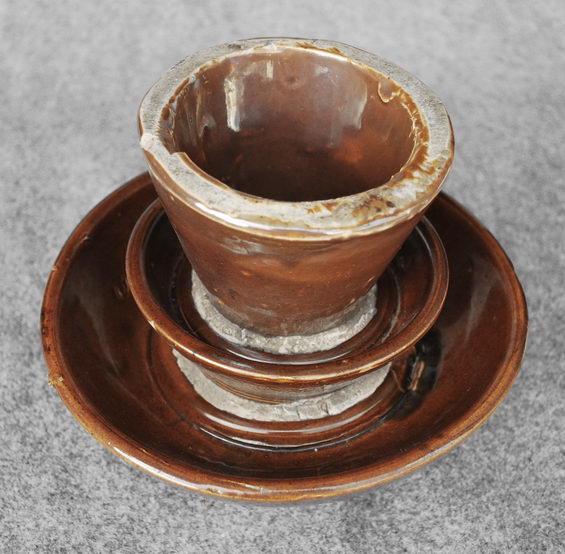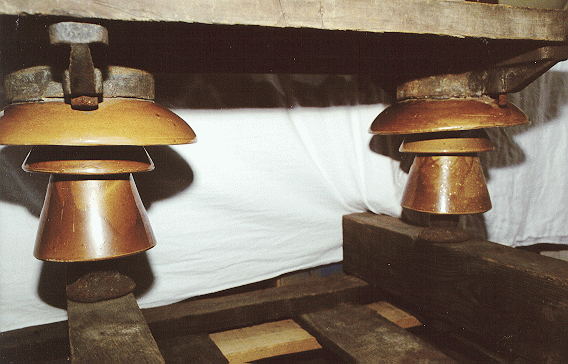
Fred Locke
Multipart Porcelain Insulators
(page 4 of 6)
Go to Main Page
Go to Multipart History Page 1 Page 2 Page 3 Page 4 Page 5 Page 6
Click on the links below to view each style:
M-3060 (Locke catalog #311)
Production date: 1903-04

M-3060 with #7-1 marking.
The M-3060 specimens known with Fred Locke markings have come from only one source a line near Sudbury, Ontario that was constructed in 1905. The line seems to have used a mix of marked and unmarked insulators intermittently. Some specimens have Fred Locke tops with later Victor shells giving the impression that the insulators used on this line were made up of both old stock skirts that were on hand at the factory and new production. Some specimens found on the line were clearly post Fred Locke Victor era made with tan shells that had finer glazes that were green trimmed and had no mold line.
Damaged Fred Locke M-3060 specimens that were clearly comprised of all Fred Locke parts were found at the site of the Alptas substation near Ballston Spa, New York along with many M-3062 specimens (see next listing). These specimens clearly had glaze and other characteristics that pointed to mid or late 1903 production.
In the years after Fred Locke introduced this design it became tremendously popular with utilities for the 23-30 kV range all across north America and literally hundreds of thousands of them were made by nearly every manufacturer up until the mid 1920's. This design was prominently shown in the 1904 Fred Locke display at the St Louis Worlds Fair.
M-3062 and M-3062A (Locke catalog #311?)
Production date: 1902-03

Early 2-part mold (left) and later 3-part mold (right).
The M-3062 was known as the "Hudson Type insulator" in various old publications and catalogs. It was first introduced in late 1902 or early 1903. Specimens from this early time frame were made with a two-part mold top shell and often have very iridescent brown glazes. Only two of these early units are known at this time and both have the 6-1 marking.
Later production versions of this same insulator have tops made in
three part molds and come with markings 6-1 or 7-1, although more plentiful,
these are still very scarce insulators. There is a distinct variation of
the Hudson design with a much enlarged inner skirt that has been assigned
M-3062A.
Only a few of these have been found and all with marking 7-1. Both of
these insulators were mainly used on the 33 kV line from the Spier Falls
powerhouse to the city of Schenectady, New York. Most of these insulators
were removed around 1910-1915 when the line was upgraded with larger insulators.
This odd sized M-3062A is a very early version. It is crudely made and the middle shell was cemented together a bit lopsided. The pinhole has a metal thimble in the threads. The marking is #7-1. I obtained this specimen from Lew Hohn back in the late 1970's.

M-3062A with #7-1 marking.


Fred Locke M-3062A with #7-1 marking.
M-3150A (Locke catalog #315)
Production date: 1903? to 1904

Only one specimen of M-3150A is known. It has Fred Locke marking 7-1 clearly stamped on the top skirt. This design was likely introduced in 1903-04 along with the M-3060 (or M-3062) and M-3236. It was listed in the 1904 Catalog and used in the Locke 1904 Worlds Fair display on the far right of the top shelf behind the M-3250. This insulator is a "kitsulator" made from unbroken shells of Fred Locke M-3150A's dug during construction at the Victor plant. A few badly damaged original cement cores of these have also been seen in the dump. No specimens of this insulator have been located by collectors on historically built lines to date with Fred Locke markings or characteristics. The earliest specimens of these found on lines by collectors were on a line built around 1905-06 from the Swan Falls Powerhouse to Nampa, Idaho, which are all unmarked. They were also used on a line near Yreka, CA. Some were marked with the later VICTOR marking but had the early tan glazes. Like the M-2430, which was first introduced by Fred Locke in 1903, this design became very popular with many early utilities in the years subsequent to Fred Locke production.. They were cataloged by every manufacturer up until the 1930's.
M-3236 (Locke catalog #311)
Production date:
In about 1999, Ben Kirsten found two M-3236's about 20 miles east of Provo, UT along Hwy 6. They were used to insulate a telephone shack on a 123 kV line. This was the first report of this rare Fred Locke multipart. The photos of Ben's two insulators with original set-up was taken at the 2000 Enumclaw, WA show.




M-3236 (10 - 7 - 7 x 10). Photo on the right shows one M-3236 still in service in Utah.
Then in 2009, Mike Spadafora discovered two broken M-3236's. He had this to say: "This large classic Fred Locke three part is marked with Locke's
#7-1 marking. I also found pieces of these with marking #6-1. This insulator was the Locke #311 first
cataloged in 1903 when a series of these three part mushroom shaped multiparts were introduced. There were basically three sizes of these
with 8", 9", and 10" tops. The actual size of these is 10-1/2 - 7 - 7 x
10". Several versions of the 8" top multipart have been found by collectors (M-3060, M-3062), the 9" top is a one of a kind insulator from the Locke
dump (M-3150A). I finally reconstructed one of these 10" versions which nearly completes my collection of Fred Locke cemented multiparts that were used on early lines. This large size was never popular and saw only one installation on a single line in Utah. The base skirt of this insulator is the same one as the M-2785 and
M-2842A. This insulator has been a real challenge to find and the top still needs some reconstructive work as you can see. I spent more then 12 hours at the pole sight collecting and digging up broken fragments to repair
it!!"
"These insulators were used on a single circuit wood pole line that ran from the Bear River Powerhouse to the Ogden, Utah steam plant and substation a distance of 45 miles. The line and plant were first built by the Utah Sugar Co. Many of the original Locke insulators failed very early on from puncture do to poor quality porcelain, cement growth, or lightning flashovers. the upper skirts were excessively thin and fragile and prone to breakage. All M-3236 insulators on the line were removed and replaced with suspension insulators by 1917. The cemented in pins used with the M-3236 were salvaged for scrap and the insulators were smashed off the pins with a hammer. Most of the line runs through developed suburban areas today."
Here are photos Mike sent during repairs of the worst specimen.


M-3236 before Mike's repairs.


The gash on the side of the crown in the photo on the right is a factory defect.

Photo above are two M-3236's. One on the left was in the worst condition and is shown in photos above and below.




Note unusual cementing ring underneath and #7-1 marking.
Go to Multipart History Page 1 Page 2 Page 3 Page 4 Page 5 Page 6
Go to Main Page